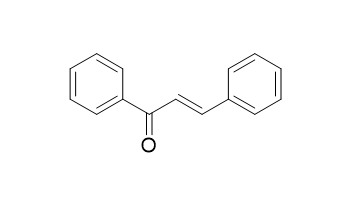1,3-Diphenyl-2-propen-1-one
1,3-Diphenyl-2-propen-1-one has anti-inflammatory, antifungal, antibacterial, antimalarial, antituberculosis, antitumor, antimicrobial and antiviral effects. It could be used to design effective inhibitors of alpha-amylase.
Inquire / Order:
manager@chemfaces.com
Technical Inquiries:
service@chemfaces.com
Tel:
+86-27-84237783
Fax:
+86-27-84254680
Address:
1 Building, No. 83, CheCheng Rd., Wuhan Economic and Technological Development Zone, Wuhan, Hubei 430056, PRC
Providing storage is as stated on the product vial and the vial is kept tightly sealed, the product can be stored for up to
24 months(2-8C).
Wherever possible, you should prepare and use solutions on the same day. However, if you need to make up stock solutions in advance, we recommend that you store the solution as aliquots in tightly sealed vials at -20C. Generally, these will be useable for up to two weeks. Before use, and prior to opening the vial we recommend that you allow your product to equilibrate to room temperature for at least 1 hour.
Need more advice on solubility, usage and handling? Please email to: service@chemfaces.com
The packaging of the product may have turned upside down during transportation, resulting in the natural compounds adhering to the neck or cap of the vial. take the vial out of its packaging and gently shake to let the compounds fall to the bottom of the vial. for liquid products, centrifuge at 200-500 RPM to gather the liquid at the bottom of the vial. try to avoid loss or contamination during handling.
Genes Environ.2024, 46(1):13.
Manomaniam Sundaranar University2023, 3859769.
J Ginseng Res.2023, 47(4):593-603.
bioRxiv2021, 462065.
J Food Sci.2021, 86(9):3810-3823.
Food Chem.2024, 460(Pt 1):140472.
Hum Exp Toxicol.2017, 36(11):1169-1176
Industrial Crops and Products2019, 140:111612
Molecules.2021, 26(4):816.
BMC Plant Biol.2020, 20(1):214.
Related and Featured Products
Mini Reviews in Medicinal Chemistry, 2013,13(1):87-94.
Anti-Inflammatory Trends of 1, 3-Diphenyl-2-propen-1-one Derivatives.[Reference:
WebLink]
Chalcones (1,3-Diphenyl-2-propen-1-one) are constituted by a three carbon α, β-unsaturated carbonyl system. The biosynthesis of flavonoids and isoflavonoids is initiated by chalcones. Notable pharmacological activities of chalcones and its derivatives include anti-inflammatory, antifungal, antibacterial, antimalarial, antituberculosis, antitumor, antimicrobial and antiviral effects respectively. Owing to simplicity of the chemical structures and a huge variety of pharmacological actions exhibited, the entities derived from chalcones are subjected to extensive consideration.
METHODS AND RESULTS:
This review article is an effort to sum up the anti-inflammatory activities of chalcone derived chemical entities. Effect of chalcones on lipid peroxidation, heme oxygenase 1(HO-1), cyclooxygenase (COX), interleukin 5 (IL-5), nitric oxide (NO) and expression of cell adhesion molecules (CAM) is summarized stepwise.
Molecular Biology Reports, 2011,38(3):1617-1620.
Trans-chalcone: a novel small molecule inhibitor of mammalian alpha-amylase.[Reference:
WebLink]
METHODS AND RESULTS:
Trans-chalcone (1,3-Diphenyl-2-propen-1-one), a biphenolic core structure of flavonoids precursor was tested for inhibitory activity toward alpha-amylase. Porcine pancreatic alpha-amylase was observed to be effectively inhibited by this compound, which showed competitive behavior with a K i of 48 μM. Soluble starch (the natural substrate of the enzyme) was used in this study in order to obtain more realistic results. The possible binding mode of the compound was assessed in silico, and the two residues Trp59, and Tyr62 were proposed as main interacting residues with trans-chalcone.
CONCLUSIONS:
In conclusion, this compound could be used to design effective inhibitors of alpha-amylase.
Current Cancer Drug Targets, 2014, 14(2).
Molecular Targeted Approaches to Cancer Therapy and Prevention Using Chalcones.[Reference:
WebLink]
There is an emerging paradigm shift in oncology that seeks to emphasize molecularly targeted approaches for cancer prevention and therapy.
METHODS AND RESULTS:
Chalcones (1,3-Diphenyl-2-propen-1-ones), naturally-occurring compounds with widespread distribution in spices, tea, beer, fruits and vegetables, consist of open-chain flavonoids in which the two aromatic rings are joined by a three-carbon α, β-unsaturated carbonyl system. Due to their structural diversity, relative ease of chemical manipulation and reaction of α, β-unsaturated carbonyl moiety with cysteine residues in proteins, some lead chalcones from both natural products and synthesis have been identified in a variety of screening assays for modulating important pathways or molecular targets in cancers. These pathways and targets that are affected by chalcones include MDM2/p53, tubulin, proteasome, NF-kappa B, TRIAL/death receptors and mitochondria mediated apoptotic pathways, cell cycle, STAT3, AP-1, NRF2, AR, ER, PPAR-γ and β-catenin/Wnt. Compared to current cancer targeted therapeutic drugs, chalcones have the advantages of being inexpensive, easily available and less toxic; the ease of synthesis of chalcones from substituted benzaldehydes and acetophenones also makes them an attractive drug scaffold.
CONCLUSIONS:
Therefore, this review is focused on molecular targets of chalcones and their potential implications in cancer prevention and therapy.



